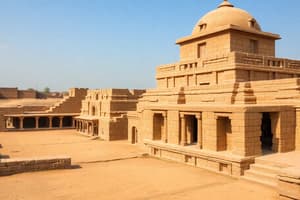Podcast
Questions and Answers
In which region did the Harappan civilization flourish?
In which region did the Harappan civilization flourish?
The Indus Valley region, which includes modern-day Pakistan and northwestern India.
What were the three phases of the Harappan civilization?
What were the three phases of the Harappan civilization?
The Early Harappan phase (3300-2600 BCE), the Mature Harappan phase (2600-1900 BCE), and the Late Harappan phase (1900-1300 BCE).
What were the notable features of the cities in the Harappan civilization?
What were the notable features of the cities in the Harappan civilization?
Cities were built with baked brick and had advanced drainage systems.
What were the primary crops grown by the Harappans?
What were the primary crops grown by the Harappans?
What were the Harappans skilled in, apart from farming?
What were the Harappans skilled in, apart from farming?
What was the extent of the Harappans' trade networks?
What was the extent of the Harappans' trade networks?
What was the structure of the Harappans' social hierarchy?
What was the structure of the Harappans' social hierarchy?
What is the significance of the Harappans' written script?
What is the significance of the Harappans' written script?
What was the likely cause of the Harappan civilization's decline?
What was the likely cause of the Harappan civilization's decline?
Flashcards are hidden until you start studying
Study Notes
Geography and Climate
- The Harappan civilization flourished in the Indus Valley region, which includes modern-day Pakistan and northwestern India.
- The civilization thrived in the fertile plains surrounding the Indus River and its tributaries.
Timeline
- The Early Harappan phase: 3300-2600 BCE
- The Mature Harappan phase: 2600-1900 BCE
- The Late Harappan phase: 1900-1300 BCE
Cities and Architecture
- Major cities: Mohenjo-Daro, Harappa, Lothal, and Kalibangan
- Cities were built with baked brick and had advanced drainage systems
- The Great Bath at Mohenjo-Daro is a notable architectural achievement
Economy and Trade
- The Harappans were skilled farmers, growing crops like wheat, barley, and cotton
- They were also skilled craftsmen, producing pottery, jewelry, and metalwork
- Trade networks extended to Mesopotamia, the Persian Gulf, and China
Social Hierarchy
- The Harappans had a complex, three-tiered social hierarchy:
- Rulers and priests
- Merchants and artisans
- Laborers and farmers
Writing System
- The Harappans had a written script, but it remains undeciphered
- Over 4000 inscriptions have been found, mostly on seals and pottery
Decline and Legacy
- The Harappan civilization declined around 1900 BCE, likely due to climate change and drought
- The Harappans made significant contributions to urban planning, architecture, and water management
- Their legacy can be seen in the development of later Indian civilizations
Studying That Suits You
Use AI to generate personalized quizzes and flashcards to suit your learning preferences.




